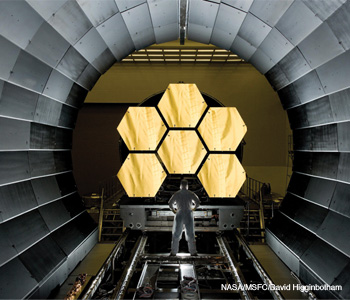 NASA engineer Ernie Wright looks on as the first six flight-ready James Webb Space Telescope primary mirror segments are prepped to begin final cryogenic testing at NASA’s Marshall Space Flight Center.
NASA engineer Ernie Wright looks on as the first six flight-ready James Webb Space Telescope primary mirror segments are prepped to begin final cryogenic testing at NASA’s Marshall Space Flight Center.
Imagine an optical instrument filled with sophisticated optical elements that no one has ever built before, from giant mirrors made with one of the lightest elements to moving shutters the width of a few human hairs. Then imagine sending it all off on a bone-shattering ride to a place so far away that no human can ever touch it again.
Such an instrument is taking shape on both sides of the Atlantic Ocean as researchers build the James Webb Space Telescope (JWST). First proposed when the Hubble Space Telescope was brand new, the JWST will have infrared-only detectors to catch photons from the earliest days of the universe, and to avoid thermal noise it will orbit the sun in distant gravitational lockstep with the Earth.
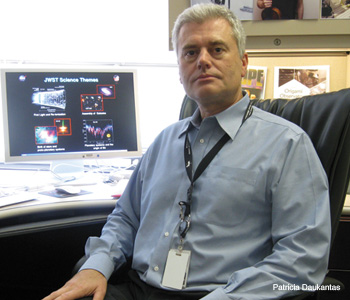 Mark Clampin, one of the leaders of the JWST team at NASA Goddard.
Mark Clampin, one of the leaders of the JWST team at NASA Goddard.
The telescope needs a primary mirror that is far wider than any rocket, so the JWST team has had to figure out how to build it in segments and prepare it for unfolding in the vacuum of space. Also mindful of Hubble’s original aberration and the human work that was required to fix it, researchers have been constantly testing and cross-checking their work so that the observatory will perform well out of astronauts’ reach.
NASA officials originally called this observatory the Next Generation Space Telescope, or NGST, but they switched its name to honor the U.S. space agency’s second administrator, who ran it during the glory days of Apollo. Along the way, NASA forged collaborations with the European and Canadian space agencies, five aerospace companies and two academic institutes. The headquarters of the effort is at NASA Goddard Space Flight Center in Greenbelt, Md., but five other NASA centers are providing test facilities or developing components of the observatory. Heading up the scientific effort is Goddard’s John Mather, a Nobel laureate in physics for his studies of cosmic background radiation.
Meeting JWST’s overall science goals
As the observatory project scientist, NASA Goddard astronomer Mark Clampin must make sure every part of the telescope—from the mirrors and instruments to the sun shields and supporting electronics—meets the design requirements for achieving JWST’s overarching scientific goals.
To image very faint objects in the infrared, the telescope needs a huge light-collecting area, diffraction-limited performance at 2 µm and a lack of stray light from the telescope. At wavelengths shorter than 10 µm, observers want to be limited by the astronomical sources themselves, requiring cryogenic operation for low background signal.
Three of JWST’s four detecting instruments will operate in the near-infrared range, from just shy of 1 µm to 5 µm; the fourth will cover the range from 5 to 29 µm. For some searches, astronomers will cast their initial net at short wavelengths and then plan additional mid-infrared observations to study the properties of newly discovered objects.
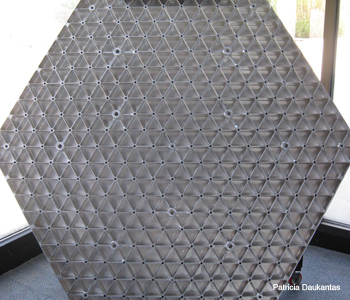 A full-scale aluminum model of one of the 18 primary mirror segments sits on display at the NASA Goddard visitor center in Greenbelt, Md.
A full-scale aluminum model of one of the 18 primary mirror segments sits on display at the NASA Goddard visitor center in Greenbelt, Md.
The basic design of the telescope is called a three-mirror anastigmat; it resembles a standard Cassegrain telescope only in that a large primary mirror, with an opening in its middle, gathers the light and bounces it off a secondary mirror in front of it. JWST doesn’t have a telescope “tube” like Hubble does; three struts will unfold during its deployment to hold the secondary mirror in place.
The secondary mirror will focus the light into the aft optical subsystem, which contains the tertiary mirror and a fine-steering mirror that helps to stabilize the image. Behind the light-collecting area, the Integrated Science Instrument Module (ISIM), essentially a truss made of carbon-epoxy composite, holds the four scientific payloads in place.
Each of the instruments in the ISIM has a pick-off mirror that can capture the light beam and route it into the chosen instrument. Early in the JWST design, the instrument teams had to negotiate for the space their experiments would occupy, and then they had to fit all their components into the allocated space. “In essence, you’re given a box and you can’t violate the box,” said Joseph M. Howard, JWST’s lead optical designer at NASA Goddard. “You have to fit whatever you need inside the box.”
Because it was designed for repairs by visiting astronauts, the Hubble Space Telescope was in low Earth orbit, with 45 minutes in warm daylight and the other 45 getting cold. “It’s not what you’d call a benign thermal environment,” Clampin said.
A telescope the size of Hubble—with a light-collecting area of only 4.5 m2, which is small by ground-based astronomical standards—could get by in that orbit, but a bigger telescope would never produce stable images in such an environment. Thus, JWST will fly out to the Lagrangian point called L2, 1.5 million km from Earth on the opposite side from the sun. Five layers of sun shades will provide passive cooling, for a much longer-duration mission than would be possible using liquid-helium chilling. (An earlier infrared observatory, the Spitzer Space Telescope, launched in 2003, ran out of liquid helium in May 2009. The rise in its thermal signature now limits its observations to wavelengths shorter than 5 µm.)
Hubble |
JWST |
|
Type of telescope |
Ritchey-Chrétien Cassegrain |
Three-mirror anastigmatic |
Primary mirror type |
Single glass mirror, coated with aluminum and magnesium fluoride |
Parabolic beryllium mirror in 18 segments, coated with gold |
Primary mirror diameter |
2.4 m |
6.5 m at widest point |
Primary mirror mass |
828 kg |
705 kg |
Light-collecting area |
4.5 m2 |
25 m2 |
Spectral range |
115 to 2,500 nm |
0.7 to 29 µm |
Orbit |
Earth orbit, 569 km altitude |
Sun orbit, 1.5 million km from Earth at the L2 Lagrange point |
Launch |
April 24, 1990, from NASA space shuttle Discovery; five repair missions |
Possibly in 2018 via Ariane 5 rocket provided by European Space Agency |
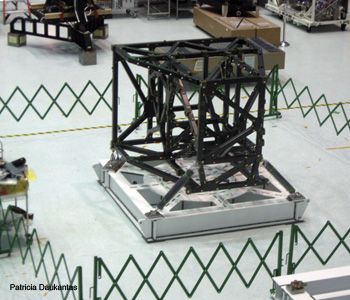 The Integrated Science Instrument Module sits in the center of NASA Goddard’s clean room. All four of JWST’s science instruments will be attached to
The Integrated Science Instrument Module sits in the center of NASA Goddard’s clean room. All four of JWST’s science instruments will be attached to
this structure.
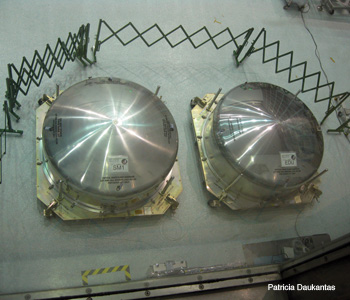 Nitrogen-filled containers in NASA Goddard’s clean room will store the completed JWST mirrors until they are ready for integration into the spacecraft.
Nitrogen-filled containers in NASA Goddard’s clean room will store the completed JWST mirrors until they are ready for integration into the spacecraft.
Mirrors: Lightweight and golden
JWST’s primary mirror consists of 18 separate mirror segments, which will unfold themselves shortly after launch. Astronomers have previously incorporated segmented mirrors into ground-based telescopes, notably the twin Keck observatories in Hawaii. While the environment of space removes some of the challenges of those scopes—like the need for adaptive optics to remove atmospheric distortion—it introduces others. Those issues include keeping the mirrors as lightweight as possible, configuring the segments in Earth gravity so that they will stay focused in zero-G and aligning them in outer space.
“We stole some ideas from Keck,” said Lee D. Feinberg, a NASA Goddard scientist and JWST’s optical telescope element manager. To get the mirrors roughly aligned, JWST will use the same coarse phasing algorithm that Keck did—but without the Hawaii observatory’s dedicated wavefront sensor. “When you’re flying in space, you can’t afford the mass and the volume,” Feinberg said.
So the optical team borrowed the technique that helped fix the Hubble telescope’s spherical aberration. By outfitting JWST’s lead science camera, NIRCam, with prisms and weak lenses that can move into the light path when needed, scientists can intentionally defocus the images of point sources. Then they will use the same phase-retrieval techniques that diagnosed Hubble’s aberration to fine-tune the primary mirror segments to give JWST an overall wavefront error within 150 nm, according to Howard.
“When we started, we thought the mirrors were the hardest part of this,” Feinberg said. Early on, JWST researchers started building “engineering design units,” or EDUs—exact copies of major components, which would undergo all the testing procedures first before the flight units were built. The primary mirror segment EDU helped the optical team learn how to compensate for figure errors that would show up at 50 K but not at room temperature.
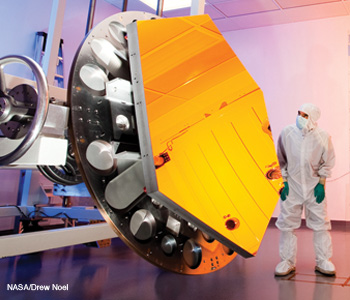 The James Webb Space Telescope engineering design unit’s primary mirror segment, coated with gold by Quantum Coating Inc.
The James Webb Space Telescope engineering design unit’s primary mirror segment, coated with gold by Quantum Coating Inc.
Each primary mirror has six actuators, providing seven degrees of freedom. These actuators will move in 10-nm steps and provide ±5 mm of range at 50 K.
“You have to align the mirrors as though they’re one monolithic mirror,” Feinberg said. A height difference of 10 nm between segments is like having a 10-nm wavefront error on a single mirror. In space, the mirrors won’t sag due to gravity, but the optical team has had to compensate for 100 to 200 nm of gravitational sag during the figuring process here on Earth.
JWST’s primary mirror will have an areal density (mass per unit area) that is 10 times lower than Hubble’s, Feinberg said. Since mirror stiffness is a function of both diameter and thickness, dividing the Webb’s mirror into segments gave the team the ability to cut way back on the mass.
Instead of glass, the JWST optical designers made the mirrors out of beryllium, one of the lightest metals and one with a relatively low coefficient of thermal expansion. The back side of each mirror segment has a typical triangular honeycomb structure with thin ribs to support the mirror’s figure against the huge stresses of a rocket launch, which could make the structures vibrate like drumheads.
The beryllium comes from Utah mines, which developed a new grade of spherical, isotropic beryllium pellets in a process called hot-isostatic pressing. The future mirror segments criss-crossed the United States to 11 different locations for casting, basic surface machining and precise optical polishing. The team lost one mirror blank to manufacturing mistakes early in the process, but learned from the problem.
As of mid-September, all of JWST’s mirrors have had their optical surfaces covered with gold, which the researchers chose for its superior reflectivity at wavelengths longer than 650 nm. Earlier this year, the first six of the 18 primary mirror segments underwent an important test in a cryogenic (down to 50 K) vacuum chamber at NASA Marshall Space Flight Center in Huntsville, Ala. The second six mirrors were in the Marshall chamber at press time, and the final six mirrors will go there at the end of this year. Finally, the mirrors will be stored in specially designed nitrogen-filled containers until the telescope is assembled.
Hidden optical innovation in the backplane
The telescope’s backplane is made out of a composite laminate: layers of graphite and epoxy that are formed into pipes with a nearly square cross-section. It rings almost like a metal pipe when tapped by a small object.
The composite’s advantage is that it is lightweight for its strength; Feinberg said the backplane beams would be much heavier if they were made of Invar, a nickel steel alloy with a low coefficient of thermal expansion. The material was designed for stability down to a few nanometers at 40 to 50 K.
“That’s one of the many subtle technological developments we had to do for JWST,” Feinberg said. In another innovation that won’t fly in space but still benefited the project, NASA researchers invented a high-speed speckle interferometer that can operate remotely and at cryogenic temperatures, so that the team could verify the backplane’s stability in the cold vacuum chamber.
NIRCam: JWST’s original camera
The near-infrared camera dubbed NIRCam has been part of the JWST plans since the beginning of the project. Principal investigator Marcia Rieke, an astronomy professor at the University of Arizona in Tucson, has been working on the instrument since 2001.
NIRCam works between 0.7 and 5 µm, so that it can cut through interstellar dust with ease. Among the JWST instruments, this camera will probably generate many of the gorgeous images that the public now associates with Hubble.
Since NIRCam incorporates the wavefront sensing and control mechanisms for aligning the primary mirror segments, its optical train must be perfect or flaws will be imprinted in all the other images, Rieke said. The NIRCam team’s goal is to have 1/30-wave optics. “For something that works at cryogenic temperatures, it’s a very good feat,” she added.
The Arizona team had to pioneer some extra-sturdy lens mounts that would not move when cooled down or launched. Researchers at Lockheed Martin’s Advanced Technology Center in Palo Alto, Calif., which works with the university on NIRCam, developed a special epoxy to hold the triplet lens groups in the mounts. “Usually people don’t like to glue things to optical surfaces when you go cryo,” Rieke said, but a special laboratory in Colorado tested them in JWST’s operating temperature range and found them sufficient.
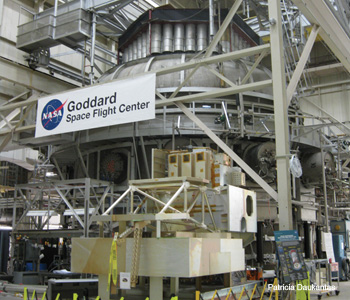 NASA Goddard’s cryogenic vacuum chamber can test individual JWST instruments and components, but the integrated telescope will require the much roomier chamber at NASA Johnson Space Center.
NASA Goddard’s cryogenic vacuum chamber can test individual JWST instruments and components, but the integrated telescope will require the much roomier chamber at NASA Johnson Space Center.
In addition to the wavefront sensor and weak lenses for the deployable primary mirror, NIRCam will have a relatively large field of view, which is particularly necessary when one is searching for first galaxies. (Think of the famous Hubble Deep Field image on steroids.)
The camera’s detectors are 2,048 x 2,048 HgCdTe arrays of 18-µm-square pixels. They have the same basic technology as the near-infrared channel of the Wide Field Camera 3 installed on the Hubble in 2009, but NIRCam has separate arrays for wavelengths shorter and longer than 2.5 µm.
The engineering test unit for NIRCam was completed in April 2010, and Rieke estimated that the team is about two-thirds of the way through assembling the flight version. Intensive testing of the flight version is scheduled for January for a possible delivery to the NASA Goddard integration team in the summer of 2012.
NIRSpec, FGS and TFI
Spectrographic images usually don’t make the front pages in newspapers, but spectroscopy “puts the physics in astrophysics,” as one Hubble researcher has commented. The European Space Agency is building NIRSpec, which will become JWST’s workhorse spectrograph in the near-infrared. It will use the same type of 2,048-pixel-square HgCdTe arrays as NIRCam.
NIRSpec will be able to record spectra of up to 100 different astronomical sources simultaneously. For the past two decades, ground-based telescopes have used fiber-optic schemes to perform multi-object spectroscopy, but JWST will take a different route thanks to micro-electro-mechanical systems technology.
To block out unwanted objects from view, the spectrograph will have four grids of micro-shutters, each 100 x 200 µm in size. Each grid consists of 365 shutters along the dispersion axis and 171 shutters along the spatial axis. Tiny electric signals specify which shutters are needed for an observation, and then a magnetic arm sweeps over the array to open or close them. Each shutter has a field of view of 0.20 x 0.45 arcseconds.
JWST’s Fine Guidance Sensor (FGS) will continuously observe guide stars with its near-infrared HgCdTe sensors to keep the observatory pointed accurately at its targets. Packaged with the FGS is a near-infrared camera called the Tunable Filter Imager (TFI). It will complement NIRCam by taking images with narrower-band filters than the larger camera. The Canadian Space Agency is developing both FGS and TFI.
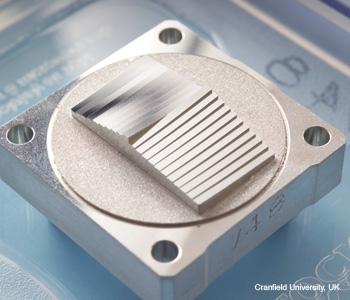 One of the solid aluminum image slicers in the MIRI spectrometer. It will split incoming light into a number of slices, N, and direct the N output beams toward a series of N slits.
One of the solid aluminum image slicers in the MIRI spectrometer. It will split incoming light into a number of slices, N, and direct the N output beams toward a series of N slits.
MIRI: Mid-infrared along for the ride
The Mid-Infrared Instrument (MIRI) is the only one aboard JWST that will look at wavelengths longer than 5 µm. According to Scott Friedman, a MIRI team member at the Space Telescope Science Institute in Baltimore, Md., Earth’s atmosphere is largely opaque in this spectral region, though there are a few windows. Yet these wavelengths are crucial to scientists searching for exoplanets and even the molecular progenitors of life.
According to the U.S. MIRI science team leader, George Rieke of the University of Arizona, the entire mid-infrared region was not included in the original plans for JWST, but NASA agreed to include an instrument for that wavelength range if other countries would pick up half the cost. Thus, funding for MIRI is split 50-50 between the United States and a multi-nation consortium organized by the European Space Agency. George Rieke’s European counterpart is Gillian Wright of the U.K. Astronomy Technology Centre.
It’s been a complicated collaboration, Rieke said, and at first MIRI was not accepted as an integral part of the observatory. Despite the complex lines of authority, the MIRI team bonded together, and by now, he added, “the 15-legged octopus has got up and learned to walk.”
Since MIRI will do both imaging and spectroscopy, its interior design is like “a complex Swiss clock,” said instrument scientist Alistair Glasse, also of the U.K. Astronomy Technology Centre.
The light path inside MIRI relies on gold-coated mirrors rather than lenses, because the former provide more throughput in this spectral region. Instead of HgCdTe detector arrays, MIRI will have 1,024-pixel square arrays of arsenic-doped silicon, Friedman said. The detector material was also used on the Spitzer Space Telescope, but MIRI will have 16 times more pixels for more impressive imaging.
With spectroscopy, scientists are not merely interested in the spatial distribution of light on the sky, but also in the spectral distribution at each point on the image, Glasse said. Since MIRI covers such a wide spectral range, the European MIRI team devised “image slicers” to split the incoming beam into four spectral bands. According to Glasse, space and mass constraints on the instrument drove this design innovation.
MIRI also features two types of coronagraphs, which block out the central light of a bright astronomical object, enabling scientists to study faint details in its vicinity. Not only does the instrument have a standard “Lyot coronagraph” consisting of a dark central mask, but it also employs a four-quadrant phase mask, or FQPM.
The FQPM is like a square filter plate divided into quarters, Glasse explained. Opposite quarters of the plate are out of phase by half a wavelength. When the bright star is centered on the “cross” where the four quadrants meet, destructive interference will null out a good deal of its light. The technique, used on some ground-based telescopes but not previously in space, should help astronomers detect Jupiter-class planets close to their central stars.
The Jet Propulsion Laboratory (JPL) in Pasadena, Calif., is providing the detectors and cooling systems for MIRI, according to Glasse. Even though the five layers of JWST’s sunshades provide passive cooling to roughly 40 K, MIRI’s detectors require an operating temperature of only 7 K. Originally MIRI was supposed to fly with a Dewar of solid hydrogen, which is at 20 K, but that scheme was nixed because the hydrogen would run out eventually. Thus JPL designed a pulse-tube-based mechanical chiller that won’t depend on a finite supply of coolant.
|
George Rieke believes that, of the JWST instruments, MIRI is the one most likely to uncover planets or other masses that scientists don’t know about yet. MIRI will bring back “the excitement of discovery,” he added.
Lessons learned and launch planning
Despite all the innovations going into JWST, NASA has looked backward in one crucial way. According to Clampin, the agency has taken the lessons learned from Hubble’s mirror-flaw debacle and incorporated them into the philosophy of how it builds the new observatory.
Researchers are doing multiple tests on both the EDUs and the actual flight components and extensively cross-checking them to ensure, for example, that people aren’t testing the mirrors with the wrong prescription. “They did cross-checks on Hubble, but they didn’t believe them,” Clampin said. “They really didn’t understand what the cross-checks were telling them.”
“From an optical perspective, there’s only one major challenge left [to JWST], and it’s the final system test,” Feinberg said. Once the telescope and its instruments are integrated—perhaps four years from now—it will be tested in a huge vacuum chamber that NASA Johnson Space Center in Houston, Texas, built for the Apollo moon lander back in the 1960s. Two vendors are supplementing the chamber’s liquid nitrogen system, which cools to 77 K, with liquid helium so that the researchers can examine the alignment of everything at 40 K. It will be the closest simulation of the space environment before the actual launch, which may not occur until 2018 due to budgetary issues (see sidebar on the right).
JWST’s design lifetime is five years, Clampin said, but team members hope that the observatory’s pointing thrusters will have enough fuel to keep going for 10 or 11 years. Of course, humans won’t be able to swap out the 18 primary mirror segments to give them new coatings, or to add new instruments as imaging technology improves. But astronomers expect big scientific payoffs that will drive their research well into the 21st century. As Feinberg said: “JWST is not an end in itself, but a stepping stone to the future.”
Patricia Daukantas is a freelance writer specializing in optics and photonics.
References and Resourcess
>> R.G. Lyon et al. Opt. Photon. News 9(7), 35 (1998).
>> J. Casani et al. James Webb Space Telescope (JWST) Independent Comprehensive Review Panel (ICRP) Final Report.
>> J.P. Gardner et al. Space Sci. Rev. 123, 485 (2006).
>> P. Daukantas. Opt. Photon. News 19(10), 30 (2008).
>> M.E. Ressler et al. Proc. SPIE 7021, 70210O (2008).
>> B. Saif et al. Appl. Opt. 47, 737 (2008).
>> A. Stark. Opt. Photon. News 19(9), 18 (2008).
>> G.S. Wright et al. Proc. SPIE 7021, 70210T (2008).
>> L. Billings. Nature 467, 1028 (2010).
>> D.M. Chaney et al. Proc. SPIE 8150, 815008 (2011).
>> E. Hand. Nature 475, 276 (2011).
>> NASA maintains an extensive JWST website.
>> The Space Telescope Science Institute has information for the general public.
>> A website devoted to MIRI.
>> JWST Live “Webb-cam”.
